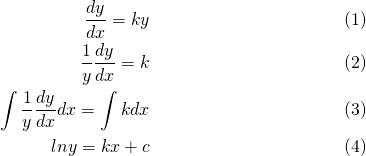Separable Differential Equations: dy/dx = ky
In this video, we work through the process of solving for the general solution of a simple separable differential equation:

The general solution is obtained by separating the variables so that all y's appear on the left hand side, while the x's appear on the right hand side of the equation. Thus...

Then integrating both sides...

We get:

We can then solve for y by raising both sides to the power of e to get

then finally...

As you see, this equation represents exponential growth. We apply this general solution to an ecological problem where excess phosphates cause an algae bloom in a lake and calculate the time it takes for the surface of the lake to be covered in algae!
Thanks for watching. Please give me an Upvote and Resteem if you have found this video helpful.
Please ask me a maths question by commenting below and I will try to help you in future videos.
I would really appreciate any small donation which will help me to help more math students of the world.
Tip me some DogeCoin: A4f3URZSWDoJCkWhVttbR3RjGHRSuLpaP3
Tip me at PayPal: https://paypal.me/MasterWu
When you say 'integrating both sides' isn't this sort of disguised chain rule rather than sort of an algebra technique (ie adding 5 to both sides)?
Can you please clarify what you mean by disguised chain rule?
The fundamental principle of algebra is applied here in that what we do to one side, we must do to the other to maintain equality.
So you are integrating one side with respect to x and the other side with respect to y, and the justification is we 'integrate both sides' in the same way as 'we add 5 to both sides' but it isn't clear that the operations are equivalent. So something like this I can follow:

Because each time exactly the same operation occurs. Perhaps one can justify integrating with respect to different variables with the definition of the integral?
Ah now I see. Yeah, I've skipped a step where you've shown it in equations (2) and (3). When I say that I've separated the variables, I've divided both sides by y, and multiplied both sides by dx, so that all of the y's appear on the LHS and all of the dx's appear on the RHS after cancelling.
Note that dy/dx can be regarded as the quotient of 2 differentials, which means they are separable - they don't have to stay together.
I think I've explained it better in the video, as well as my previous video, rather than the text I've posted.